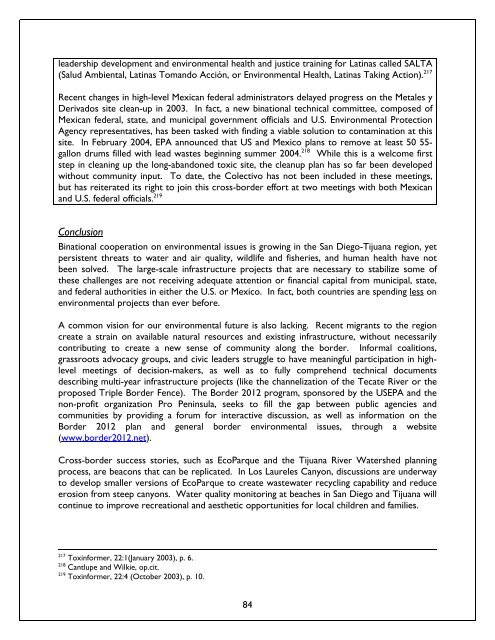Blurred Borders - International Community Foundation
Blurred Borders - International Community Foundation
Blurred Borders - International Community Foundation
You also want an ePaper? Increase the reach of your titles
YUMPU automatically turns print PDFs into web optimized ePapers that Google loves.
leadership development and environmental health and justice training for Latinas called SALTA<br />
(Salud Ambiental, Latinas Tomando Acción, or Environmental Health, Latinas Taking Action). 217<br />
Recent changes in high-level Mexican federal administrators delayed progress on the Metales y<br />
Derivados site clean-up in 2003. In fact, a new binational technical committee, composed of<br />
Mexican federal, state, and municipal government officials and U.S. Environmental Protection<br />
Agency representatives, has been tasked with finding a viable solution to contamination at this<br />
site. In February 2004, EPA announced that US and Mexico plans to remove at least 50 55gallon<br />
drums filled with lead wastes beginning summer 2004. 218 While this is a welcome first<br />
step in cleaning up the long-abandoned toxic site, the cleanup plan has so far been developed<br />
without community input. To date, the Colectivo has not been included in these meetings,<br />
but has reiterated its right to join this cross-border effort at two meetings with both Mexican<br />
and U.S. federal officials. 219<br />
Conclusion<br />
Binational cooperation on environmental issues is growing in the San Diego-Tijuana region, yet<br />
persistent threats to water and air quality, wildlife and fisheries, and human health have not<br />
been solved. The large-scale infrastructure projects that are necessary to stabilize some of<br />
these challenges are not receiving adequate attention or financial capital from municipal, state,<br />
and federal authorities in either the U.S. or Mexico. In fact, both countries are spending less on<br />
environmental projects than ever before.<br />
A common vision for our environmental future is also lacking. Recent migrants to the region<br />
create a strain on available natural resources and existing infrastructure, without necessarily<br />
contributing to create a new sense of community along the border. Informal coalitions,<br />
grassroots advocacy groups, and civic leaders struggle to have meaningful participation in highlevel<br />
meetings of decision-makers, as well as to fully comprehend technical documents<br />
describing multi-year infrastructure projects (like the channelization of the Tecate River or the<br />
proposed Triple Border Fence). The Border 2012 program, sponsored by the USEPA and the<br />
non-profit organization Pro Peninsula, seeks to fill the gap between public agencies and<br />
communities by providing a forum for interactive discussion, as well as information on the<br />
Border 2012 plan and general border environmental issues, through a website<br />
(www.border2012.net).<br />
Cross-border success stories, such as EcoParque and the Tijuana River Watershed planning<br />
process, are beacons that can be replicated. In Los Laureles Canyon, discussions are underway<br />
to develop smaller versions of EcoParque to create wastewater recycling capability and reduce<br />
erosion from steep canyons. Water quality monitoring at beaches in San Diego and Tijuana will<br />
continue to improve recreational and aesthetic opportunities for local children and families.<br />
217 Toxinformer, 22:1(January 2003), p. 6.<br />
218 Cantlupe and Wilkie, op.cit.<br />
219 Toxinformer, 22:4 (October 2003), p. 10.<br />
84















